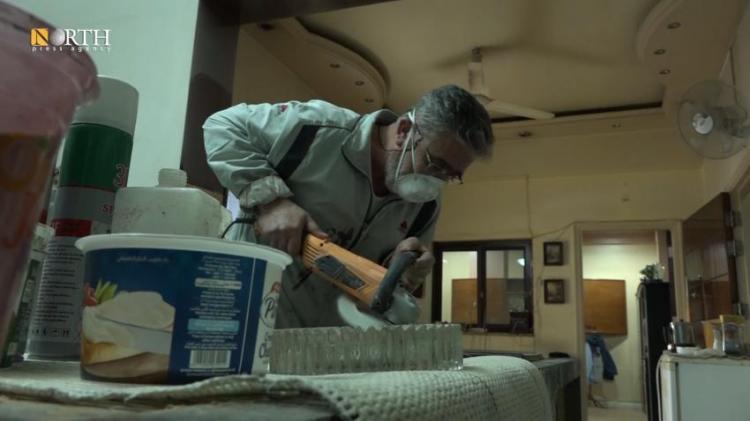A Syriac passionate for art in Qamishli, northeastern Syria
Qamishli – North-Press Agency
Reem Chamoun/Charbel Henno
In a small workshop in the city of Qamishli, northeastern Syria, Marwan Shakro is working on unique paintings in the region using epoxy material that is used to add aesthetic to the floors and walls of the houses. Shakro has been using the material that is used by some artists around the world creating unique paintings and artworks for nearly a year.
Epoxy painting is considered one of the modern international arts that has witnessed a noticeable spread during the past few years, where those who use it in the works of decorations, drawing, and sculpting publish videos of their work on social media, especially on YouTube, which Shakro greatly benefited from.
Beginnings
"I wanted to learn something else in the art. I saw epoxy on YouTube, and it raised my curiosity, so I asked about it in Damascus and knew that there are two companies that produce and work with this material, so I started getting it and working with it, according to my follow-up on YouTube workers." Shakro said.
Shakro, who earned a bachelor’s degree in electrical engineering, became interested in art about 35 years ago when he was a student in his first secondary class, when the art teacher distinguished his drawings from the drawings of the rest of his classmates. This increased his desire to learn more about the arts.
Shakro tries to return his memory to the 1980s when he entered the university and started to practice plastic art, Arabic calligraphy, Syriac calligraphy, and Surrealist art that expresses his great admiration. He thinks that "it is hyper realistic art based on freedom and spontaneity in expressing ideas and opinions…I try to be interested in the content of art instead of its form through artistic paintings embodying this state. This is a French doctrine of drawing," he said.
"I was forced to study electrical engineering at the University of Aleppo because of society's lack of acceptance of studying drawing and my economic situation at that time. I graduated from university in 1989 and I am now working in my office on general trade because I did not get a suitable job as an electrical engineer,” he said sorrowfully.
The engineer devoted a small room in his office for general trade to work on his hobby with epoxy. He is the only one making art with this material within the Jazira region.
He said that working with this material requires patience, learning many other professions such as blacksmithing and carpentry, and it requires mastery of mathematical operations because of the need to measure the quantities of the material used, in addition to the accuracy of the work.
"I learned carpentry and blacksmithing because they are related to this work. When I work on wood, I have to know how to cut the wood and how to clean it, as well as iron and other solid materials, and this made me learn many new things,” he added.
"The craft of the future"
Epoxy is an ancient material, but it has evolved in the last ten years. "International engineers and artists have discovered transparent epoxy, and the fourth and newer generation of the material is a plastic material added to the granules of the crystal, so that it gives rigidity and a three-dimensional image to the surface placed on it."
High-quality types of this material have not reached Syria yet, but globally, the work started on it in several fields, such as painting on boards, hard surfaces, kitchens, bedrooms, salons, and on walls, which is a strong break-proof, anti-acid material that does not absorb moisture. Its users call it "the craft of the future".
When he works, Shakro focuses on creating paintings related to Syriac heritage in the region, and says that his love for the Syriac heritage made him draw paintings that express the culture of his community.
Attendance and fame
In addition to his fame in this type of art, the engineer has a reputation within the Syriac circles in the city, especially since he chaired the Syriac Milli Council, a council affiliated with the Syriac Orthodox Church, between 2010 and 2012. The council runs the administrative matters in the church and its affiliated institutions in the region.
In the past, a church affiliated institution exhibited his works in several local exhibitions. "The church-affiliated family of St. Afram exhibited many of my own paintings in the exhibitions that it held, in which it presented surrealist works, pyrography (wood burning), sculpting on plaster, drawing on the skin, and paintings in the Syriac script.”
In the meantime, Shakro is preparing to exhibit his epoxy work in an exhibition that is scheduled to be held in July and August, "according to the regional situation and the state of the curfew imposed to prevent coronavirus.”
"The exhibition will be shared with artists working on handicrafts and other paintings, but I will be the only one to display epoxy paintings,” he added.
"Purposeful Art"
Shakro believes that any art without a goal to affect the society or the individual "will remain a state of art only.” He also believes that art should participate in "shaping the principles of society, changing the way of thinking, and transmitting heritage and values to future generations."
He has created 15 epoxy paintings that he will show in the upcoming exhibition. Marwan Shakro hopes that he can continue his journey of passion for art and painting and develop his talent, and make epoxy a well-known art in the Qamishli region in general.

